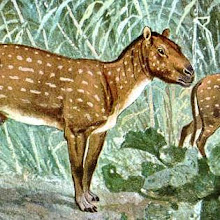Next, I shall discuss the Trilobite. The Trilobite was a creature that lived from the Early Cambrian to the Late Permian Period. Trilobite means “three lobes.” The reason for this is not due to 3 body segments, but instead due to an axial lobe and left and right pleural lobes. “Pleural” means side or rib, not a grammatical number which dictates how nouns change if there is more than one of that noun. Some trilobites lived on the ocean floor and were predators, scavengers, or filter feeders. Others lived out in the open ocean and fed on plankton. Trilobite is not as specific a grouping as the Pterygotus, because “Pterygotus” identifies 4 known species while “Trilobite” identifies over 20,000. Trilobites, like other arthropods, have exoskeletons made out of chitin. They also, like other arthropods, are divided into segments. Trilobites are divided into the cephalon, a segmented thorax, and a pygidium. The Pygidium is a tail peace. I’m guessing you know what a thorax is, and as for the cephalon, try and use the prefix to find out. The Cephalon contains the eyes, antennae, mouth, and a few pairs of legs. The Thorax contains legs and gills under each segment. The segments also allow a trilobite to roll into a protective ball. The Pygidium is ade up of fused segments, unlike the thorax, where you can see more divisions. The Pygidium varies in size among trilobite species. The four general sizes are micropygous, much smaller than the cephalon, subisopygous, smaller than isopygous, but still similar size, isopygous, the same size as the cephalon, and macropygous, larger than the cephalon. The Trilobites were one of the first animals with compound eyes, although there are some that are eyeless. The two major types of eyes trilobites have. One is the holochroal, compound eyes with no division between individual lenses, somewhat like the eyes of most insects you see. The other is the schizochroal, which has circular segments instead of hexagonal and are divided by sclera, cuticular exoskeleton material, which is somewhat lower than the lenses. As you may have guessed, I like trilobites, but I am not the expert about information relating to them. Most of the information here was from
http://www.trilobites.info/trilobite.htm. If you find any incorrect information, please comment on it. For those who play Pokemon, Kabuto is like a trilobite, but with a smoother shell, fewer legs, and no place where you can identify segmentation. Apparently, Kabutops is supposed to resemble a eurypterid, but I only partially see the resemblance. You can look at the Pterygotus picture yourself and decide if it looks like a Kabutops. Now, my discussion of Paleozoic life is over. My favorite animals from the prehistoric Cenozoic Era will be discussed next. One Dinosaur will be discussed, but not yet.

No comments:
Post a Comment